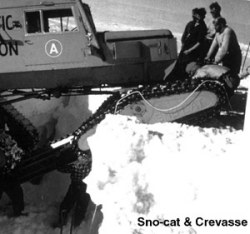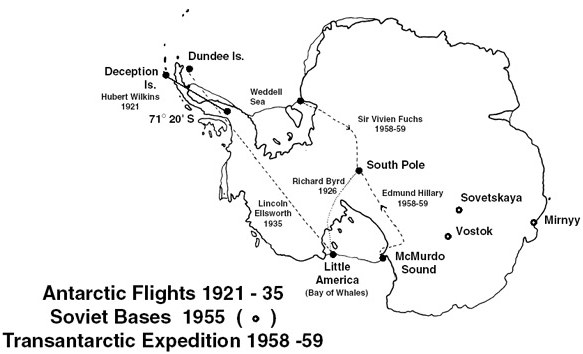
| Glasgow Digital Library | Voyage of the Scotia | BRUCE | PEOPLE | SHIP | ANTARCTIC | INDEX |
|---|
International co-operation reached a peak during the International Geophysical Year. A number of new bases were set up before this time, so research and exploration was ready to begin in the Antarctic summer of 1957-58. A total of 55 scientific stations were established and 12 nations took part.

This was the first successful transantarctic expedition. The route followed was similar to that proposed by William Speirs Bruce and Ernest Shackleton. Transport was to be on large tracked vehicles called sno-cats with one dog team. Aircraft were to be used for reconnaissance.
Fuch's party left the Filchner ice sheet in the Weddell Sea and made for Amundsen-Scott Base at the South Pole. A New Zealand Party, led by Edmund Hillary (who had made the first ascent of Everest) led a party from the Ross Sea towards the pole laying supply dumps. His main system of transport was Massey Ferguson tractors. Hillary reached the South Pole before Fuchs, so becoming the third party to reach the pole overland. Fuchs' party and the New Zealand party then returned to the Ross Sea. Fuchs had taken just 99 days to make the first crossing of the Antarctic continent.
'We also unfurled the flag of the Scottish National Antarctic Expedition 1901-04, which had been taken by William Speirs Bruce on his voyage in the Scotia, when he discovered Coats Land on the east side of the Weddell Sea. This had been handed to me in Edinburgh by the President of the Royal Scottish Geographical Society with the request that we should carry it with us to Coats Land and on across the continent'.
Sir Vivian Fuchs

| Glasgow Digital Library | Voyage of the Scotia | BRUCE | PEOPLE | SHIP | ANTARCTIC | INDEX |
|---|